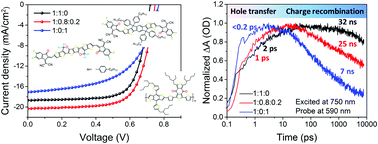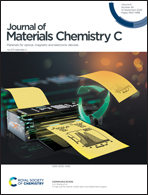Impacts of a second acceptor on the energy loss, blend morphology and carrier dynamics in non-fullerene ternary polymer solar cells†
Abstract
Using a ternary blend consisting of two donors/one acceptor or one donor/two acceptors is a potential strategy to increase the power conversion efficiency (PCE) of polymer solar cells (PSCs). Herein, ternary PSCs based on PBDB-T:IT-4F:O6T-4F blends have been investigated by employing narrow bandgap O6T-4F as a second acceptor. Our studies indicate that introduction of 20% O6T-4F in the acceptor moiety can increase the PCE from 9.5% for the binary PBDB-T:IT-4F (1 : 1) cell to 10.5% for the ternary PBDB-T:IT-4F:O6T-4F (1 : 0.8 : 0.2) cell. The enhancement is attributed to a compromise between the increased short-circuit current (JSC) and open-circuit voltage (VOC) and the decreased fill factor (FF) with addition of the O6T-4F acceptor. It is shown that O6T-4F lowers the energy loss (Eloss) occurring in the binary PBDB-T:IT-4F (1 : 1) blend, leading to a higher VOC of the ternary PSCs with regard to the binary PBDB-T:IT-4F PSCs. Eloss is decreased from 0.80 eV for the binary PBDB-T:IT-4F (1 : 1) blend to 0.61 eV for the ternary PBDB-T:IT-4F:O6T-4F (1 : 0.8 : 0.2) blend. At the same time, the addition of the O6T-4F acceptor reduces the aggregation of the PBDB-T donor in the ternary blends. Ultra-fast transient absorption demonstrates that the hole transfer and subsequent carrier recombination occur faster in the ternary blend than in the PBDB-T:IT-4F blend, which accounts for a slightly decreased FF in the ternary PSCs.



 Please wait while we load your content...
Please wait while we load your content...